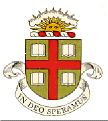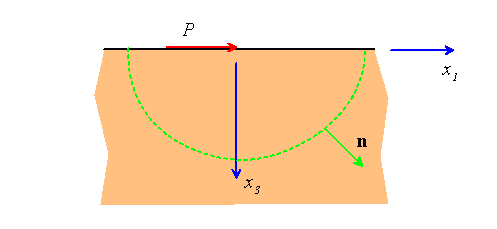 EN224:
Linear Elasticity
EN224:
Linear Elasticity 
 EN224:
Linear Elasticity
EN224:
Linear Elasticity 
Division of Engineering
1. Tangentially loaded half-space.

(1.1) State the appropriate boundary conditions for a half-space subjected to a point force acting tangent to its surface, as shown in the figure.
(1.2) Examine the list of Boussinesq potentials given at the end of Sect 3.1 of the online lecture notes. Consider solutions A, B and E, which generate stresses from harmonic potentials
as follows:
Following the procedure outlined in Sect
3.7 for a normally loaded half-space, find a way to combine solutions
A, B, and E so as to generate an elastostatic state which automatically
satisfies ![]() on the surface of the half-space. You should find you
can generate the required solution from a single harmonic potential,
on the surface of the half-space. You should find you
can generate the required solution from a single harmonic potential, ![]() .
Set up the boundary conditions that represent a point force at the origin.
.
Set up the boundary conditions that represent a point force at the origin.
(1.3) Take Fourier transforms of the governing equations and boundary conditions found in (1.2). Hence, deduce that the transform of the required potential satisfies

Use the result for the normally loaded half-space to write down![]() and hence deduce the potential
and hence deduce the potential ![]() (Use of Mathematica or Maple to
do the integral is strongly recommended!)
(Use of Mathematica or Maple to
do the integral is strongly recommended!)
(1.4) Determine the displacement field for the tangentially loaded half-space.
2. A direct computation of the Eshelby tensor for a spherical region. Consider a stress free, infinite isotropic linear elastic solid. Suppose that we introduce a uniform eigenstrain
within a spherical region radius a with center at the origin.
Recall that a problem involving a distribution of eigenstrains can be recast as an equivalent problem involving a distribution of body forces. Show that for the present case, the body force distribution consists of a layer of body force acting on the surface of the sphere, and may be expressed as
Using the results for the strain distribution associated with the Kelvin state listed at the end of Sect. 3.2 of the online lecture notes, verify that the components of the Eshelby tensor are listed correctly in Sect. 3.6. You may assume that the strain distribution is uniform within the sphere, so it is sufficient to compute the strains at the center of the sphere. You are encouraged to use your favorite symbolic manipulation program…
3. Energetics of Eigenstrains. Consider a homogeneous, stress free, linear elastic solid with elastic constants
. Suppose that an eigenstrain distribution
is introduced into a bounded subregion of the solid B. Let
denote the total strain distribution in the solid.
Show that the total strain energy of the solid is
To do this, begin by writing down the strain energy within B. Then, write down an expression for the total strain energy outside B in terms of the traction acting on the boundary of B. Then find a way to rearrange the sum of these two terms into the form given above.
4. General Axisymmetric Contact. Suppose that two isotropic, linear elastic spheres
with radii
and moduli and Poisson’s ratios
are pressed into contact.
Assume that if the two spheres did not deform, they would overlap by a distance h as shown in the figure.
Make the following assumptions:
(1) The radius of the contact area between the two spheres is much smaller than the radius of either sphere.
(2) Both spheres deform as though they were infinite half-spaces. That is to say, the radial displacement of a point on the surface of sphere A due to a point force acting a distance r away on its surface is

(3) Approximate the profile of each sphere by a parabola.
Write down an integral equation for the contact pressure distribution acting between the spheres, in terms of the sphere radii and the elastic constants.
Compare the result with the integral equation that governs the pressure distribution acting between a rigid sphere and an elastic half-space. Hence, find expressions for the radius of the contact area between the spheres, the contact pressure distribution and the relationship between the load P and the approach of remote points on the spheres h.